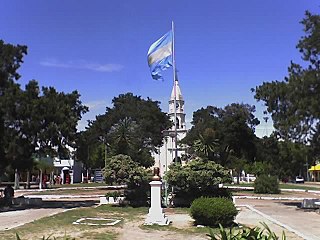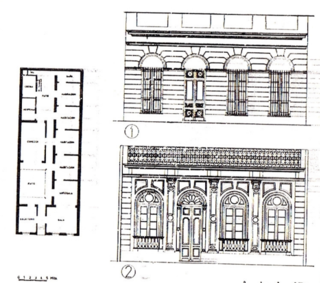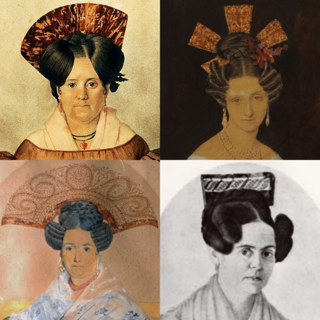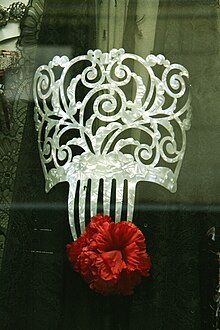
Buenos Aires, officially the Autonomous City of Buenos Aires, is the capital and primate city of Argentina. The city is located on the western shore of the Río de la Plata, on South America's southeastern coast. "Buenos Aires" is Spanish for "fair winds" or "good airs". Buenos Aires is classified as an Alpha global city, according to the Globalization and World Cities Research Network (GaWC) 2020 ranking.

Buenos Aires, officially the Buenos Aires Province, is the largest and most populous Argentine province. It takes its name from the city of Buenos Aires, the capital of the country, which used to be part of the province and the province's capital until it was federalized in 1880. Since then, in spite of bearing the same name, the province does not include Buenos Aires city, though it does include all other parts of the Greater Buenos Aires metropolitan area. The capital of the province is the city of La Plata, founded in 1882.

A comb is a tool consisting of a shaft that holds a row of teeth for pulling through the hair to clean, untangle, or style it. Combs have been used since prehistoric times, having been discovered in very refined forms from settlements dating back to 5,000 years ago in Persia.

The Argentine War of Independence was a secessionist civil war fought from 1810 to 1818 by Argentine patriotic forces under Manuel Belgrano, Juan José Castelli, and José de San Martín against royalist forces loyal to the Spanish crown. On 9 July 1816, an assembly met in San Miguel de Tucumán, declaring independence with provisions for a national constitution.

Candombe is a style of music and dance that originated in Uruguay among the descendants of liberated African slaves. In 2009, the United Nations Educational, Scientific and Cultural Organization (UNESCO) inscribed candombe in its Representative List of the Intangible Cultural Heritage of Humanity.

Greater Buenos Aires, also known as the Buenos Aires Metropolitan Area, refers to the urban agglomeration comprising the Autonomous City of Buenos Aires and the adjacent 24 partidos (districts) in the Province of Buenos Aires. Thus, it does not constitute a single administrative unit. The conurbation spreads south, west and north of Buenos Aires city. To the east, the River Plate serves as a natural boundary.

1830s fashion in Western and Western-influenced fashion is characterized by an emphasis on breadth, initially at the shoulder and later in the hips, in contrast to the narrower silhouettes that had predominated between 1800 and 1820.

Palermo is a barrio or neighborhood of Buenos Aires, Argentina. It is located in the north of the city, near the Rio de la Plata.

Fashion dolls are dolls primarily designed to be dressed to reflect fashion trends. They are manufactured both as toys for children to play with and as collectibles for adults. The dolls are usually modeled after teen girls or adult women, though child, male, and even some non-human variants exist. Contemporary fashion dolls are typically made of vinyl or another plastic.

A mantilla is a traditional female liturgical lace or silk veil or shawl worn over the head and shoulders, often over a high hair ornament called a peineta, particularly popular with women in Spain and Latin America. It is also worn by Catholic and Plymouth Brethren women around the world, Mennonite women in Argentina, and without the peineta by Eastern Orthodox women in Russia. When worn by Eastern Orthodox women the mantilla is often white, and is worn with the ends crossed over the neck and draped over the opposite shoulder. The mantilla is worn as a Christian headcovering by women during church services, as well as during special occasions. A smaller version of the mantilla is called a toquilla.

The Argentine Naval Prefecture is a service of Argentina's Security Ministry charged with protecting the country's rivers and maritime territory. It therefore fulfills the functions of other countries' coast guards, and furthermore acts as a gendarmerie force policing navigable rivers.

Merlo is the head town of the eponymous partido of Merlo and seat of the municipal government, located in the Greater Buenos Aires urban area of Buenos Aires Province, Argentina.

Afro-Argentines are people in Argentina of primarily Sub-Saharan African descent. The Afro-Argentine population is the result of people being brought over during the transatlantic slave trade during the centuries of Spanish domination in the region and immigration from Africa.

Foreign relations between Argentina and France, have existed nearly a century. Both states are members of the G-20.

The National Military College is the institution in charge of the undergraduate education of officers of the Argentine Army. It is located at El Palomar, Buenos Aires.
There are many landmarks in Buenos Aires, Argentina some of which are of considerable historical or artistic interest.

Antonio Ruiz was an Argentine soldier and national hero of Argentina. Ruiz, nicknamed Falucho, was an Afro-Argentine soldier of the Independence War. Ruiz fought in José de San Martín’s army. According to the most common story, Corporal Ruiz, born a slave, served in the Regiment of the River Plate and died while defending the colors of the revolutionary flag against traitors during a revolt at the fort of El Callao, Peru) on February 6, 1824. Rather than hoist the Spanish flag, Falucho chose to be shot by the traitors, crying out with his last breath "¡Viva Buenos Aires!".

José de San Martín is the national hero of Argentina, Chile and Peru, and along with Simón Bolívar, the most important Libertador of the Spanish American Wars of Independence. For this reason, he is homaged and depicted in several cultural works of those countries, and even internationally. He led the Campaign across the Andes from Argentina to Chile which has been studied around the world for its complexity.

A Casa Chorizo, Casa Patio, or formally as Standard House is a type of house that was widely built in the late 19th and early 20th century, predominantly in Montevideo, Buenos Aires and Rosario, but to a lesser extent in many other towns and cities of Argentina and Uruguay.

The peinetón is a large, decorative comb that originated in Buenos Aires, Argentina and became very fashionable among its female inhabitants as well as those of Montevideo, Uruguay between the late 1820s and the mid to late 1830s. Although its origin can be traced back to the traditional Spanish peineta, the peinetón derived into a different headpiece altogether, both for its physical characteristics as well as for the symbolic meanings around its use. The peineta was introduced to Buenos Aires around 1815 and, as early as 1824, interest began to grow in larger and more elaborate models, eventually giving rise to the peinetón that had its heyday between 1830 and 1837. The accessory emerged during the Romantic era of Western fashion, and was worn alongside dresses with small waists and large, voluminous sleeves.



















